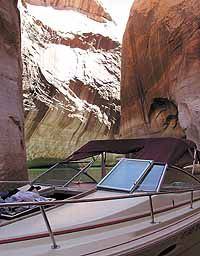| Before heading out on Utah waters, recreationalists are reminded that a new national law requires that all children under 13 years of age must wear a life jacket while aboard a watercraft. Weekend trips like this one to Lake Powell can quickly become deadly if the proper safety gear is not used properly. |
Last December, the United States Coast Guard passed a nation-wide law which requires all children under 13 years of age to wear a coast guard approved life jacket while aboard a recreational vessel. The only exception to this new requirement is when the child is below deck or in an enclosed cabin.
According to the coast guard, this rule was created to address the problem of childhood drownings while participating in boating activities.
Between 1995 and 2001, the coast guard reports that 210 U.S. children under the age of 13 died while boating. The national boating authority also explained that 121 of these deaths was due to drowning and most of them could have been prevented if the child had been wearing a properly fitted life jacket.
“Statistics show that life jackets save lives, but only when they are worn,” stated coast guard captain, Scott Evans. “Children customarily wear protective gear when rollerblading, skateboarding and bicycling and similar precautions are in order on the water. The life jacket rule was proposed to make sure that there is a life jacket rule in all states.”
In Utah, the age requirement is under 13 years of age and penalties or a boat operator who fails to have all children under this age wear a life jacket are similar to those for failing to have life jackets on board. The coast guard explains that these penalties could be assessed up to a maximum of $1,100 for each violation.
Utah boaters may be concerned as to which life jackets may be used. According Utah law, all boats must have at least one type I, II, III or V properly fitted floatation device in serviceable condition and readily accessible for each person aboard.
The following information explains what each acceptable type of floatation device in the state of Utah is and when and where it should be used.
•Type I is an off shore life jacket. It provides most buoyancy and turns most unconscious wearers to a face-up position. Effective for all waters, especially open, rough or remote waters where rescue may be delayed.
•Type II floatation devices are near shore buoyancy vests that turn some unconscious wearers to a face-up position. These devices are intended for calm, inland waters or where there is a good chance of a quick rescue.
•Type III devices are floatation aids. They are designed so wearers can place themselves in a face-up position. This type of device is available in many designs for specific water sports and activities.
•Type V floatation devices are special use products and are designed and approved only for activities listed on the manufacturers label.
Federal law also requires that all boats 16 feet or more in length must carry at least one type IV throwable device that is immediately accessible and within easy reach of the operator or passengers on board.
Each person who is being towed on water skis or other device or those who are operating or riding on a personal watercraft must wear a properly fitted U.S. Coast Guard approved floatation device according to federal law.
The Utah Division of Parks and Recreation also advises that those who are on a boat on a river must also wear a properly fitted coast guard approved floatation device.
For those older than 12 years of age, the device may be loosened or removed only while on designated flat water river sections.
For a list of these designated water sections in Utah, contact the state division of parks and recreation.
According to the U.S. Coast Guard, national statistics indicate that 75 percent of Americans who drowned in boating accidents would have survived if they had worn a floatation device.
A boating accident can happen at any time while on the water and the coast guard reminds Utahns to plan ahead, it is a safe boating practice.

